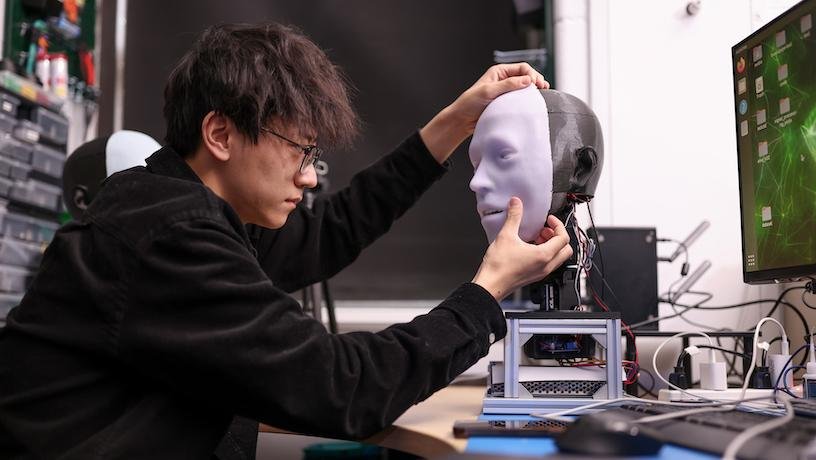Emotion in Robotics
The study's lead author, Yuhang Hu, a PhD student at Columbia Engineering.
Photo Credit: John Abbott/Columbia Engineering
In the advancing fields of artificial intelligence (AI) and robotics, the Creative Machines Lab at Columbia Engineering, is pushing the boundaries of how technology interacts with human emotion. This pioneering research, led by Hod Lipson, is illuminating a future where robots can understand and anticipate human feelings, fundamentally transforming our interactions with machines.
Understanding Emotional Connections
The exchange of smiles between individuals is a profound act of communication, signaling mutual understanding and emotional alignment. This dynamic is not only crucial for human-human interactions but also represents a significant challenge and opportunity in the development of human-robot interactions. Robots that can anticipate and mimic such expressions could greatly enhance the emotional bond between humans and machines.
From Reactive to Anticipatory Interactions
Historically, robotic responses to human emotions have been reactive. However, the goal has shifted towards creating anticipatory interactions, where robots can predict and react to human emotional states in real-time, fostering a more genuine connection. This shift is marked by significant developments, including the lab's early work on Eva, a platform that was crucial in exploring self-modeling of facial expressions. Eva's development underscored the necessity for robots to predict not only their expressions but also those of the humans they interact with, laying the groundwork for more advanced systems.
The Next Leap
Building on the foundational insights gained from Eva, the introduction of Emo represents a leap forward in robotic emotional intelligence. Emo is equipped with advanced actuation and perception technologies, enabling it to express and recognize a wide range of emotions with unprecedented precision. This capability allows Emo to engage in a form of communication that was once the sole domain of humans, bridging the gap between human and machine.
Robots Enhancing Human Communication
The development of emotionally intelligent robots like Emo suggests a future where technology can support and enhance human interaction in ways previously unimaginable. In contexts where non-verbal cues are essential for communication, such as in remote work or social distancing, robots with the ability to convey and interpret emotions could play a crucial role in maintaining the social fabric.
Embracing the Future
The journey from Eva to Emo encapsulates the evolution of robotics from simple machines to complex beings capable of understanding and participating in the human emotional experience. The work of Hod Lipson and the Creative Machines Lab is not just advancing robotics but is also reshaping our expectations of technology, moving us towards a future where our interactions with machines are as rich and meaningful as those we have with each other. As we continue to explore this frontier, the promise of robots like Emo invites us to imagine a world where technology enhances our ability to connect, understand, and empathize with one another on a deeper level.
Robot face platform
The sophisticated design of the robot's face platform, featuring a total of 26 motors dedicated to offering detailed facial expressions and neck movements.
Hu, Y., Chen, B., Lin, J., Wang, Y., Wang, Y., Mehlman, C., & Lipson, H. (2024). Human-robot facial coexpression. Science Robotics. Retrieved from https://www.science.org/doi/10.1126/scirobotics.adi4724#sec-1


